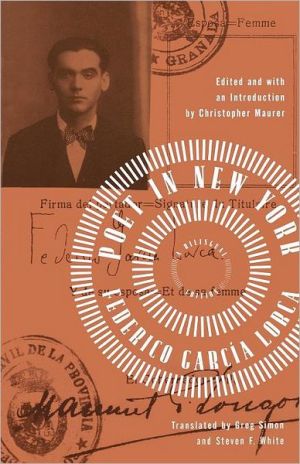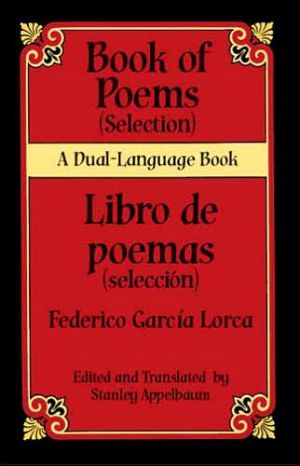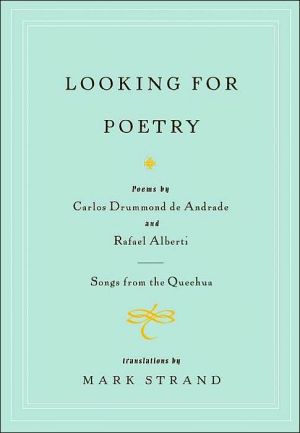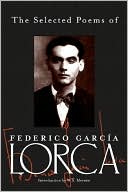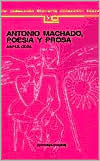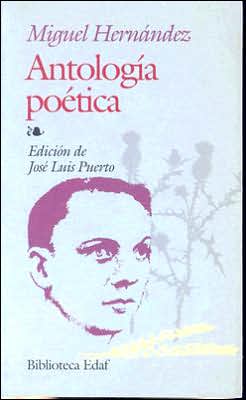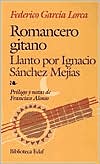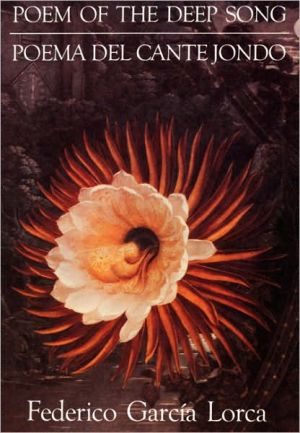Poet in New York: A Bilingual Edition
Written while Federico García Lorca was a student at Columbia University in 1929-30, Poet in New York is one of the most important books Lorca produced, and certainly one of the most important books ever published about New York City. Indeed, it is a book that changed the direction of poetry in both Spain and the Americas, a pathbreaking and defining work of modern literature.\ In honor of the poet's centenary, the celebrated Lorca scholar Christopher Maurer has revised this strange,...
Search in google:
Written while Federico García Lorca was a student at Columbia University in 1929-30, Poet in New York is one of the most important books Lorca produced, and certainly one of the most important books ever published about New York City. Indeed, it is a book that changed the direction of poetry in both Spain and the Americas, a pathbreaking and defining work of modern literature.In honor of the poet's centenary, the celebrated Lorca scholar Christopher Maurer has revised this strange, timeless, and vital book of verse, using much previously unavailable or untranslated material: Lorca's own manuscript of the entire book; witty and insightful letters from the poet to his family describing his feelings about America and his temporary home there (a dorm room in Columbia's John Jay Hall); the annotated photographs which accompany those letters; and a prose poem missing from previous editions. Complementing these new addtions are extensive notes and letters, revised versions of all the poems, and an interpretive lectures by Lorca himself.An excellent introduction to the work of one of the key figures of modern poetry, this bilingual edition of Poet in New York is also a thrilling exposition of the American city in the 20th century.Publishers WeeklyGarcia Lorca's long out-of-print poetic sequence about New York City, newly translated in this bilingual edition, is as contemporary as today's headlines: slums, racism, violence and cries of loneliness punctuate this verse. Written during the Spanish playwright's nine-month stopover in 1929-30, and steeped in surrealistic technique, his unrelentingly negative antihymn reads the urban condition as symbolic of our culture's materialistic corruption of love and its degradation of nature. Yet one can question the current validity of Garcia Lorca's howl of protest. In vocalizing the stifled rage of Harlem, he implicitly views blacks as somehow more ``natural'' than whites. Conflicted about his own homosexuality, he elevates Whitmanesque love between ``camerados'' over what he sees as a decadent gay subculture. This effective if somewhat flat translation is accompanied by Garcia Lorca's letters and a lecture he delivered on this lyrical work. (March)
IntroductionNote to the Second EditionAfter a Walk51910 (Intermezzo)7Fable of Three Friends to Be Sung in Rounds9Your Childhood in Menton15Standards and Paradise of the Blacks21The King of Harlem25Abandoned Church (Ballad of the Great War)35Dance of Death41Landscape of a Vomiting Multitude (Dusk at Coney Island)49Landscape of a Pissing Multitude (Battery Place Nocturne)53Murder (Two Early Morning Voices on Riverside Drive)57Christmas on the Hudson59Sleepless City (Brooklyn Bridge Nocturne)63Blind Panorama of New York67The Birth of Christ71Dawn73Double Poem of Lake Eden77Living Sky81Little Stanton87Cow93Little Girl Drowned in the Well (Granada and Newburgh)95Death101Nocturne of Emptied Space103Landscape with Two Graves and an Assyrian Dog111Ruin113Two Lovers Murdered by a Partridge117Moon and Panorama of the Insects (Love Poem)123New York (Office and Denunciation)133Jewish Cemetery139Crucifixion145Cry to Rome (From the Tower of the Chrysler Building)151Ode to Walt Whitman157Little Viennese Waltz169Waltz in the Branches173Blacks Dancing to Cuban Rhythms179Lecture: A Poet in New York183The Poet Writes to His Family from New York and Havana203Notes on the Poems287
\ From the Publisher"Lorca's long out-of-print poetic sequence about New York City, newly translated in this bilingual edition, is as contemporary as today's headlines: slums, racism, violence, and cries of loneliness punctuate this verse. Written during the Spanish playwright's nine-month stopover in 1929-30, and steeped in surrealistic technique, [this] unrelentingly negative antihymn reads the urban condition as symbolic of our culture's materialistic corruption of love and its degradation of nature . . . This [edition] is accompanied by Lorca's letters and a lecture he delivered on this lyrical work."—Publishers Weekly \ "[This] is one of the perplexing classics of 20th-century poetry. It is a difficult, sometimes bewildered, often hermetic work. It is elusive and enigmatic, mysterious, tortured—a book, to borrow one of the poet's own phrases, 'that can baptize in dark water all who look at it.' Reading it in [this] convincing new translation . . . one feels the anguished authority and the demonic force and impact of the original. For all its strangeness, Lorca's testament may well be one of the greatest books of poems ever written about New York City—second, perhaps, only to Walt Whitman's powerful embrace of the American megalopolis . . . [Poet in New York] is a fierce indictment of the modern world incarnated in city life, but it is also a wildly imaginative and joyously alienated declaration of residence—an apocalyptic outcry, a dark, instructive, metaphysical bowl of loneliness."—The New Yorker\ "The hermetic symbolism and turbulent images surrealistically convey Lorca's nightmarish impressions of Depression-era New York. This new version, more readable, accurate, and literal than prior translations—including Ben Belitt's (Grove, 1983), the only other integral bilingual edition available—and enhanced by addenda such as the editor's scholarly notes on the publishing history of the work, may establish the standard against which all future editions will be measured. An auspicious beginning to a planned three-volume series of Lorca's poetical works. Essential."—Library Journal\ "In its orchestration of peaks and valleys, of introspection and of the cruelty of modern industrial life, Poet in New York is stunning. Though it initially provoked some reactions of wounded patriotism here, the Andalusian poet actually put his finger on a lot of what ails us. His criticisms of our rapacity, materialism, and blindness to deep truths—not to mention more specific ills like racism—ring only too true. Lorca's gifts for graphic and intensely patterned language are abundantly displayed, along with his knack for creating a mood and stirring associations even at his most 'incomprehensibly' surrealistic: 'The moon could rest in the end along the pure white curve of the horses. / A violent beam of light that escaped from a wound / projected the instant of a dead child's circumcision on the sky.'"—David H. Rosenthal, The New York Times Book Review\ "Simon and White have recreated magnificently this pivotal work by the Spanish poet . . . The reader's understanding of Poet in New York is enhanced by an excellent introduction and notes by the editor, and is further enriched by his translation of fourteen letters written by Lorca during his stay in the New World [as well as] a translation of a lecture by Lorca [about this book] . . . At last, a translation of Lorca that succeeds."—Choice\ "[This book] does what one wants a translation to do: make the original really come alive in the second language."—W. S. Merwin\ "This is a superb translation . . . Simon and White have succeeded so well that I can't imagine anyone trying to improve on what they've done."—Mark Strand\ \ \ \ \ \ Publishers Weekly - Publisher's Weekly\ Garcia Lorca's long out-of-print poetic sequence about New York City, newly translated in this bilingual edition, is as contemporary as today's headlines: slums, racism, violence and cries of loneliness punctuate this verse. Written during the Spanish playwright's nine-month stopover in 1929-30, and steeped in surrealistic technique, his unrelentingly negative antihymn reads the urban condition as symbolic of our culture's materialistic corruption of love and its degradation of nature. Yet one can question the current validity of Garcia Lorca's howl of protest. In vocalizing the stifled rage of Harlem, he implicitly views blacks as somehow more ``natural'' than whites. Conflicted about his own homosexuality, he elevates Whitmanesque love between ``camerados'' over what he sees as a decadent gay subculture. This effective if somewhat flat translation is accompanied by Garcia Lorca's letters and a lecture he delivered on this lyrical work. (March)\ \ \ Library JournalThe hermetic symbolism and turbulent images surrealistically convey Lorca's nightmarish impressions of Depression-era New York. This new version, more readable, accurate, and literal than prior translationsincluding Ben Belitt's (Grove, 1983), the only other integral bilingual edition availableand enhanced by addenda such as the editor's scholarly notes on the publishing history of the work, may establish the standard against which all future editions will be measured. An auspicious beginning to a planned three-volume series of Lorca's poetical works. Essential. Lawrence Olszewski, OCLC, Dublin, Ohio\ \
